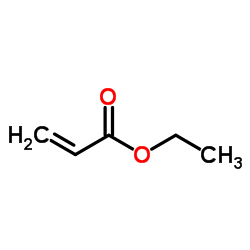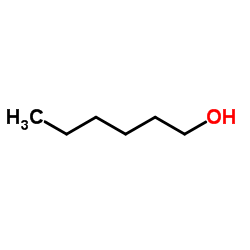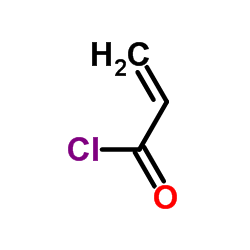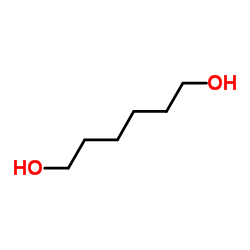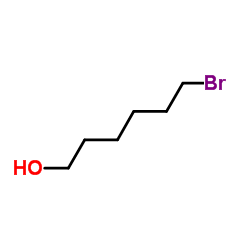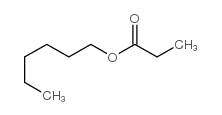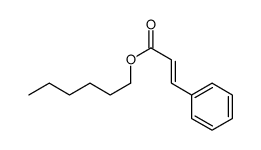2499-95-8
| Name | hexyl prop-2-enoate |
|---|---|
| Synonyms |
n-Hexylacrylate
2-Propenoic acid, hexyl ester EINECS 219-698-5 Acrylic Acid Hexyl Ester Ageflex n-HA hexyl prop-2-enoate N-Hexyl Acrylate Hexyl 2-propenoate 2-PROPENOIC ACID,HEXYL ESTER MFCD00048881 Hexyl acrylate Acrylic acid,hexyl ester acrylic acid n-hexyl ester |
| Description | Hexyl acrylate is a an initiator in Photo-initiated CVD[1]. |
|---|---|
| Related Catalog | |
| References |
| Density | 0.9±0.1 g/cm3 |
|---|---|
| Boiling Point | 191.6±9.0 °C at 760 mmHg |
| Melting Point | -45°C |
| Molecular Formula | C9H16O2 |
| Molecular Weight | 156.222 |
| Flash Point | 58.3±12.0 °C |
| Exact Mass | 156.115036 |
| PSA | 26.30000 |
| LogP | 3.45 |
| Vapour Pressure | 0.5±0.4 mmHg at 25°C |
| Index of Refraction | 1.429 |
Synonym:Hexyl 2-propenoate; 2-Propenoic acid, hexyl este Section 2 - COMPOSITION, INFORMATION ON INGREDIENTS
Risk Phrases: 36/37/38 Section 3 - HAZARDS IDENTIFICATION EMERGENCY OVERVIEW
Irritating to eyes, respiratory system and skin. Potential Health Effects Eye: Causes eye irritation. Skin: Causes mild skin irritation. May cause dermatitis. Ingestion: May cause gastrointestinal irritation with nausea, vomiting and diarrhea. Inhalation: Causes respiratory tract irritation. Chronic: No information found. Section 4 - FIRST AID MEASURES Eyes: Flush eyes with plenty of water for at least 15 minutes, occasionally lifting the upper and lower eyelids. Get medical aid. Skin: Get medical aid. Flush skin with plenty of water for at least 15 minutes while removing contaminated clothing and shoes. Wash clothing before reuse. Ingestion: If victim is conscious and alert, give 2-4 cupfuls of milk or water. Never give anything by mouth to an unconscious person. Get medical aid. Inhalation: Remove from exposure and move to fresh air immediately. If not breathing, give artificial respiration. If breathing is difficult, give oxygen. Get medical aid. Notes to Physician: Antidote: None reported. Section 5 - FIRE FIGHTING MEASURES General Information: As in any fire, wear a self-contained breathing apparatus in pressure-demand, MSHA/NIOSH (approved or equivalent), and full protective gear. Use water spray to keep fire-exposed containers cool. Combustible liquid. Vapors may be heavier than air. They can spread along the ground and collect in low or confined areas. Containers may explode when heated. Extinguishing Media: In case of fire, use water, dry chemical, chemical foam, or alcohol-resistant foam. Use water spray to cool fire-exposed containers. Section 6 - ACCIDENTAL RELEASE MEASURES General Information: Use proper personal protective equipment as indicated in Section 8. Spills/Leaks: Absorb spill with inert material (e.g. vermiculite, sand or earth), then place in suitable container. Remove all sources of ignition. Provide ventilation. Section 7 - HANDLING and STORAGE Handling: Wash thoroughly after handling. Use with adequate ventilation. Avoid contact with eyes, skin, and clothing. Empty containers retain product residue, (liquid and/or vapor), and can be dangerous. Keep container tightly closed. Keep away from heat, sparks and flame. Avoid ingestion and inhalation. Do not pressurize, cut, weld, braze, solder, drill, grind, or expose empty containers to heat, sparks or open flames. Storage: Keep away from heat, sparks, and flame. Keep away from sources of ignition. Store in a tightly closed container. Store in a cool, dry, well-ventilated area away from incompatible substances. Keep containers tightly closed. Section 8 - EXPOSURE CONTROLS, PERSONAL PROTECTION Engineering Controls: Use adequate ventilation to keep airborne concentrations low. Exposure Limits CAS# 2499-95-8: Personal Protective Equipment Eyes: Wear appropriate protective eyeglasses or chemical safety goggles as described by OSHA's eye and face protection regulations in 29 CFR 1910.133 or European Standard EN166. Skin: Wear appropriate protective gloves to prevent skin exposure. Clothing: Wear appropriate protective clothing to prevent skin exposure. Respirators: Follow the OSHA respirator regulations found in 29 CFR 1910.134 or European Standard EN 149. Use a NIOSH/MSHA or European Standard EN 149 approved respirator if exposure limits are exceeded or if irritation or other symptoms are experienced. Section 9 - PHYSICAL AND CHEMICAL PROPERTIES Physical State: Liquid Color: colorless Odor: Not available. pH: Not available. Vapor Pressure: Not available. Viscosity: Not available. Boiling Point: 88 - 90 deg C @ 24. Freezing/Melting Point: Not available. Autoignition Temperature: Not available. Flash Point: 155 deg F ( 68.33 deg C) Explosion Limits, lower: Not available. Explosion Limits, upper: Not available. Decomposition Temperature: Solubility in water: Specific Gravity/Density: .8880g/cm3 Molecular Formula: H2C=CHCO2(CH2)5CH3 Molecular Weight: 156.25 Section 10 - STABILITY AND REACTIVITY Chemical Stability: Unstable. Conditions to Avoid: Incompatible materials, ignition sources, acids, excess heat, bases, peroxides. Incompatibilities with Other Materials: Strong oxidizing agents, polymerizing initiator. Hazardous Decomposition Products: Carbon monoxide, carbon dioxide, acrylic acids. Hazardous Polymerization: May occur. Section 11 - TOXICOLOGICAL INFORMATION RTECS#: CAS# 2499-95-8: AT1450000 LD50/LC50: CAS# 2499-95-8: Oral, rat: LD50 = 26 mL/kg; Skin, rabbit: LD50 = 5660 uL/kg. Carcinogenicity: 2-propenoic acid, hexyl ester - Not listed by ACGIH, IARC, or NTP. Other: See actual entry in RTECS for complete information. Section 12 - ECOLOGICAL INFORMATION Section 13 - DISPOSAL CONSIDERATIONS Dispose of in a manner consistent with federal, state, and local regulations. Section 14 - TRANSPORT INFORMATION IATA Not regulated as a hazardous material. IMO Not regulated as a hazardous material. RID/ADR Not regulated as a hazardous material. Section 15 - REGULATORY INFORMATION European/International Regulations European Labeling in Accordance with EC Directives Hazard Symbols: XI Risk Phrases: R 36/37/38 Irritating to eyes, respiratory system and skin. Safety Phrases: S 26 In case of contact with eyes, rinse immediately with plenty of water and seek medical advice. S 37/39 Wear suitable gloves and eye/face protection. WGK (Water Danger/Protection) CAS# 2499-95-8: 1 Canada CAS# 2499-95-8 is listed on Canada's NDSL List. CAS# 2499-95-8 is not listed on Canada's Ingredient Disclosure List. US FEDERAL TSCA CAS# 2499-95-8 is listed on the TSCA inventory. SECTION 16 - ADDITIONAL INFORMATION N/A |
CHEMICAL IDENTIFICATION
HEALTH HAZARD DATAACUTE TOXICITY DATA
|
| Symbol |


GHS07, GHS09 |
|---|---|
| Signal Word | Warning |
| Hazard Statements | H315-H317-H319-H335-H411 |
| Precautionary Statements | P261-P273-P280-P305 + P351 + P338 |
| Personal Protective Equipment | Eyeshields;Faceshields;full-face respirator (US);Gloves;multi-purpose combination respirator cartridge (US);type ABEK (EN14387) respirator filter |
| Hazard Codes | Xi: Irritant;N: Dangerous for the environment; |
| Risk Phrases | 36/37/38-43-51/53 |
| Safety Phrases | S24-S26-S37-S61 |
| RIDADR | 3082 |
| WGK Germany | 2 |
| RTECS | AT1450000 |
| Packaging Group | III |
| Hazard Class | 9 |
| HS Code | 2916129000 |
| Precursor 10 | |
|---|---|
| DownStream 2 | |
| HS Code | 2916129000 |
|---|---|
| Summary | 2916129000 other esters of acrylic acid VAT:17.0% Tax rebate rate:9.0% Supervision conditions:none MFN tariff:6.5% General tariff:30.0% |



